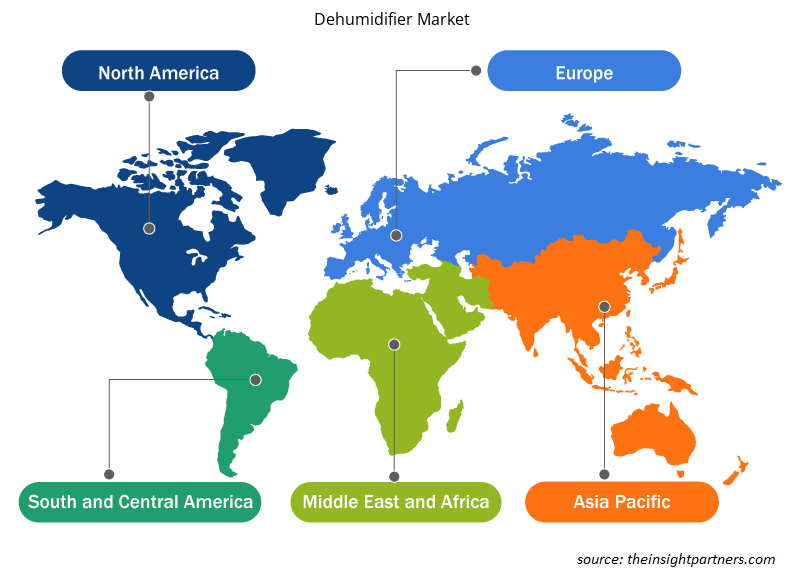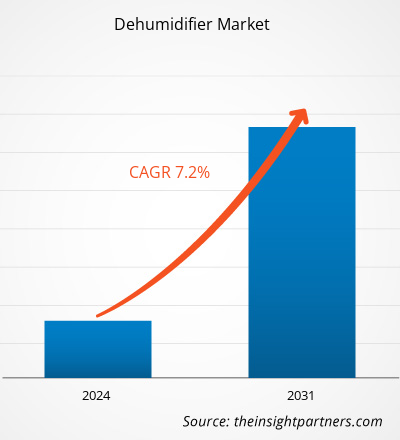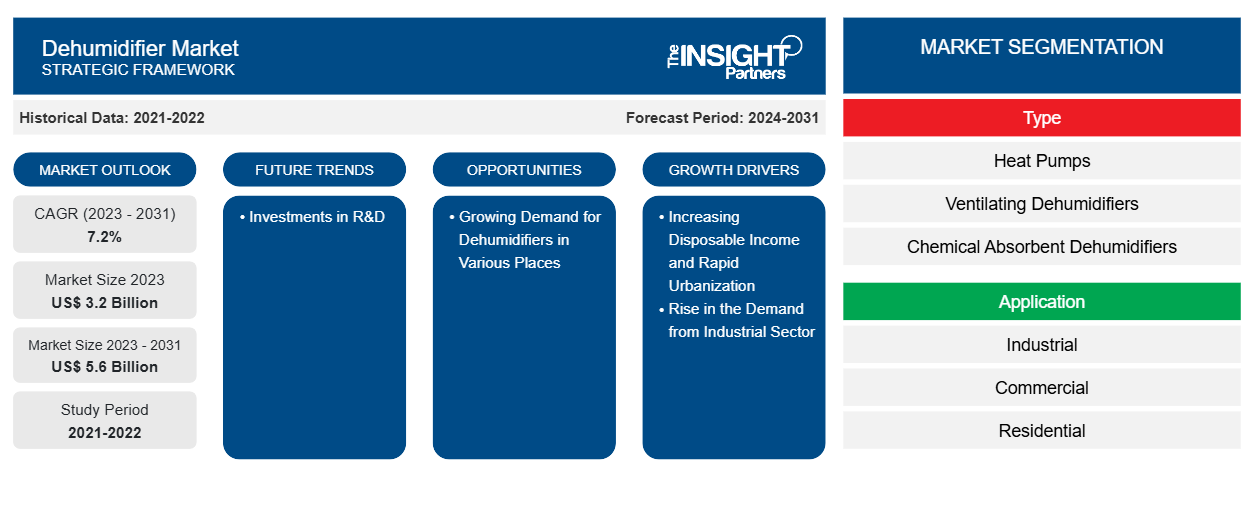La taille du marché des déshumidificateurs devrait atteindre 5,6 milliards de dollars américains d'ici 2031, contre 3,2 milliards de dollars américains en 2023. Le marché devrait enregistrer un TCAC de 7,2 % au cours de la période 2023-2031. L'augmentation du revenu disponible et l'urbanisation rapide devraient rester les principales tendances du marché.
Analyse du marché des déshumidificateurs
L'essor de l'économie mondiale, accompagné du développement urbain, a entraîné une augmentation de la construction dans différents secteurs. Ce boom de la construction, qui comprend des centres commerciaux, des hôpitaux, des immeubles de bureaux, des hôtels et des installations industrielles, a accru le besoin de déshumidificateurs. Les progrès technologiques et l'élaboration de réglementations sur l'utilisation de l'énergie au niveau gouvernemental et organisationnel ont également contribué à l'expansion du marché. On observe une tendance croissante vers les déshumidificateurs avancés capables de mesurer et de réguler indépendamment l'humidité de l'air, ainsi que l'intégration de la technologie basée sur le cloud qui permet la connectivité avec des appareils intelligents, deux éléments qui ont considérablement accéléré la croissance du marché.
Aperçu du marché des déshumidificateurs
Les réglementations imposées par le gouvernement, comme les critères de test d'efficacité énergétique définis par le ministère américain de l'Énergie, ont un impact significatif sur le comportement du marché. De plus, le marché est positivement affecté par l'amélioration du niveau de vie et la prise de conscience croissante des consommateurs concernant les facteurs liés à la santé. Le besoin croissant de déshumidificateurs portables dans les maisons et les entreprises, associé à l'intégration de commandes numériques faciles à utiliser dans les unités de déshumidification modernes, stimule l'expansion du marché, en particulier dans le secteur résidentiel. En outre, les réglementations et normes gouvernementales axées sur l'efficacité énergétique, telles que AHAM 7008-2018/ CSA SPE-7008-18/UL 7008-18, renforcent encore davantage l'utilisation des déshumidificateurs dans les secteurs résidentiel et industriel. Ces facteurs combinés contribuent à stimuler l'expansion globale du marché.
Personnalisez ce rapport en fonction de vos besoins
Vous bénéficierez d'une personnalisation gratuite de n'importe quel rapport, y compris de certaines parties de ce rapport, d'une analyse au niveau des pays, d'un pack de données Excel, ainsi que de superbes offres et réductions pour les start-ups et les universités.
-
Obtenez les principales tendances clés du marché de ce rapport.Cet échantillon GRATUIT comprendra une analyse de données, allant des tendances du marché aux estimations et prévisions.
Facteurs moteurs et opportunités du marché des déshumidificateurs
L'augmentation du revenu disponible et l'urbanisation rapide favorisent le marché
Le marché mondial des déshumidificateurs connaît une croissance en raison de plusieurs facteurs clés. L'adoption croissante des déshumidificateurs dans les espaces commerciaux et résidentiels, ainsi que l'urbanisation rapide et l'augmentation du revenu disponible, stimulent cette croissance. Dans divers pays en développement de la région Asie-Pacifique, la demande de déshumidificateurs augmente en raison des investissements croissants dans les activités de construction d'espaces résidentiels et commerciaux. Cette demande est particulièrement évidente dans les espaces de stockage où sont stockés les batteries au lithium et autres équipements électroniques. De plus, les conditions météorologiques fluctuantes causées par des facteurs tels que le réchauffement climatique contribuent à la croissance du marché des déshumidificateurs. En Europe, la demande de déshumidificateurs devrait augmenter dans les années à venir, en particulier dans les établissements tels que les restaurants, les hôtels, les centres de villégiature, les cafétérias, les centres de transformation des aliments et des boissons et les espaces de stockage frigorifiques.
Demande croissante de déshumidificateurs dans divers endroits
Les clubs de santé ont besoin de déshumidificateurs commerciaux non seulement dans les piscines et les spas, mais aussi dans les espaces d'entraînement très humides. Ces déshumidificateurs sont essentiels pour contrôler l'humidité, prévenir les problèmes tels que la moisissure, empêcher l'équipement d'entraînement de rouiller et maintenir l'intégrité globale du bâtiment . Dans les espaces compacts et humides comme ceux qui abritent des piscines thérapeutiques, des jacuzzis ou des spas, un déshumidificateur commercial est utilisé pour extraire l'excès d'humidité. De plus, en raison du volume relativement limité de la pièce par rapport à l'humidité produite, des déshumidificateurs commerciaux spécialisés à faible volume CFM sont nécessaires pour limiter le nombre de changements d'air ambiant passant par le déshumidificateur à un niveau approprié. Tous ces avantages offerts par les déshumidificateurs devraient stimuler l'adoption de ce produit.CFM commercial dehumidifiers are necessary to restrict the number of room air changes passing through the dehumidifier to a suitable level. All of these benefits provided by dehumidifiers are expected to boost the adoption of this product.
Analyse de segmentation du rapport sur le marché des déshumidificateurs
Les segments clés qui ont contribué à l’élaboration de l’analyse du marché des déshumidificateurs sont le type et l’application.
- En fonction du type, le marché est divisé en pompes à chaleur, déshumidificateurs à ventilation et déshumidificateurs à absorption chimique. Le segment des pompes à chaleur détenait une part de marché importante en 2023.
- En termes d'application, le marché est divisé en secteurs industriel, commercial et résidentiel. Le segment industriel détenait une part substantielle du marché en 2023.
Analyse des parts de marché des déshumidificateurs par géographie
La portée géographique du rapport sur le marché des déshumidificateurs est principalement divisée en cinq régions : Amérique du Nord, Asie-Pacifique, Europe, Moyen-Orient et Afrique, et Amérique du Sud et centrale.
L'Amérique du Nord devrait occuper une place importante sur le marché. Des entreprises telles que Dehumidifier Corporation of America (DCA) proposent une large gamme d'humidificateurs dans cette région. Les enceintes de piscines commerciales et les installations de spa dans les hôtels, les clubs de santé, les YMCA, les YWCA, les lycées, les universités, les résidences pour retraités, les centres de fitness et autres établissements similaires peuvent bénéficier de conditions améliorées grâce à l'utilisation de déshumidificateurs DCA, notamment pour lutter contre l'accumulation d'humidité élevée.DCA) are offering a wide range of humidifiers in this region. Commercial swimming pool enclosures and spa facilities in hotels, health clubs, YMCAs, YWCAs, high schools, universities, retirement communities, fitness centers, and other similar establishments can experience improved conditions with the use of DCA dehumidifiers, particularly in combating high moisture accumulation.
Aperçu régional du marché des déshumidificateurs
Les tendances et facteurs régionaux influençant le marché des déshumidificateurs tout au long de la période de prévision ont été expliqués en détail par les analystes d’Insight Partners. Cette section traite également des segments et de la géographie du marché des déshumidificateurs en Amérique du Nord, en Europe, en Asie-Pacifique, au Moyen-Orient et en Afrique, ainsi qu’en Amérique du Sud et en Amérique centrale.

- Obtenez les données régionales spécifiques au marché des déshumidificateurs
Portée du rapport sur le marché des déshumidificateurs
| Attribut de rapport | Détails |
|---|---|
| Taille du marché en 2023 | 3,2 milliards de dollars américains |
| Taille du marché d'ici 2031 | 5,6 milliards de dollars américains |
| Taux de croissance annuel composé mondial (2023-2031) | 7,2% |
| Données historiques | 2021-2022 |
| Période de prévision | 2024-2031 |
| Segments couverts |
Par type
|
| Régions et pays couverts |
Amérique du Nord
|
| Leaders du marché et profils d'entreprises clés |
|
Densité des acteurs du marché : comprendre son impact sur la dynamique des entreprises
Le marché des déshumidificateurs connaît une croissance rapide, tirée par la demande croissante des utilisateurs finaux en raison de facteurs tels que l'évolution des préférences des consommateurs, les avancées technologiques et une plus grande sensibilisation aux avantages du produit. À mesure que la demande augmente, les entreprises élargissent leurs offres, innovent pour répondre aux besoins des consommateurs et capitalisent sur les tendances émergentes, ce qui alimente davantage la croissance du marché.
La densité des acteurs du marché fait référence à la répartition des entreprises ou des sociétés opérant sur un marché ou un secteur particulier. Elle indique le nombre de concurrents (acteurs du marché) présents sur un marché donné par rapport à sa taille ou à sa valeur marchande totale.
Les principales entreprises opérant sur le marché des déshumidificateurs sont :
- Société du groupe Haier
- Electrolux AB
- LG Électronique
- Société Whirlpool
- Appareils électroménagers De'Longhi Srl
- Filtres Généraux, Inc.
Avis de non-responsabilité : les sociétés répertoriées ci-dessus ne sont pas classées dans un ordre particulier.

- Obtenez un aperçu des principaux acteurs du marché des déshumidificateurs
Actualités et développements récents du marché des déshumidificateurs
Le marché des déshumidificateurs est évalué en collectant des données qualitatives et quantitatives après des recherches primaires et secondaires, qui comprennent d'importantes publications d'entreprise, des données d'association et des bases de données. Quelques-uns des développements sur le marché des déshumidificateurs sont énumérés ci-dessous :
- Quest Climate, pionnier dans le secteur du contrôle de l'humidité, est ravi d'annoncer un partenariat stratégique avec BFG Supply, un distributeur renommé de produits de jardinage, de pépinière et d'horticulture, à compter de 2024. Cette collaboration marque une étape passionnante pour les deux entreprises, visant à redéfinir les normes en matière de solutions de contrôle environnemental pour les industries du jardinage et de la culture. Quest a toujours été le leader du marché avec une technologie de déshumidification innovante et performante, répondant aux divers besoins des environnements de culture et des applications industrielles. Avec son engagement en matière de fiabilité, d'efficacité énergétique et de durabilité, Quest a acquis une réputation d'excellence et est devenu le choix incontournable des producteurs du monde entier.
(Source : Quest, site Web de l'entreprise, décembre 2023)
- AprilAire, leader national des solutions d'air sain de qualité professionnelle pour la maison, propose une innovation inspirée et des économies d'énergie prouvées avec sa gamme de déshumidificateurs de la série E. Les modèles E080, E100 et E130 offrent aux consommateurs 23 % d'économies d'énergie annuelles par rapport aux produits conventionnels et bénéficient de la certification ENERGY STAR® Most Efficient 2022. Ces déshumidificateurs AprilAire sont les premiers déshumidificateurs pour toute la maison à recevoir cette certification d'ENERGY STAR et ont reçu cette certification pendant deux années consécutives.
(Source : AprilAire, site Web de l'entreprise, avril 2022)
Rapport sur le marché des déshumidificateurs : couverture et livrables
Le rapport « Taille et prévisions du marché des déshumidificateurs (2021-2031) » fournit une analyse détaillée du marché couvrant les domaines ci-dessous :
- Taille et prévisions du marché des déshumidificateurs aux niveaux mondial, régional et national pour tous les segments de marché clés couverts par le champ d'application
- Tendances du marché des déshumidificateurs ainsi que la dynamique du marché telles que les moteurs, les contraintes et les opportunités clés
- Analyse détaillée des cinq forces de PEST/Porter et SWOT
- Analyse du marché des déshumidificateurs couvrant les principales tendances du marché, le cadre mondial et régional, les principaux acteurs, les réglementations et les développements récents du marché
- Analyse du paysage industriel et de la concurrence couvrant la concentration du marché, l'analyse de la carte thermique, les principaux acteurs et les développements récents pour le marché des déshumidificateurs
- Profils d'entreprise détaillés
- Analyse historique (2 ans), année de base, prévision (7 ans) avec TCAC
- Analyse PEST et SWOT
- Taille du marché Valeur / Volume - Mondial, Régional, Pays
- Industrie et paysage concurrentiel
- Ensemble de données Excel
Rapports récents
Témoignages
Raison d'acheter
- Prise de décision éclairée
- Compréhension de la dynamique du marché
- Analyse concurrentielle
- Connaissances clients
- Prévisions de marché
- Atténuation des risques
- Planification stratégique
- Justification des investissements
- Identification des marchés émergents
- Amélioration des stratégies marketing
- Amélioration de l'efficacité opérationnelle
- Alignement sur les tendances réglementaires























 Obtenez un échantillon gratuit pour - Marché des déshumidificateurs
Obtenez un échantillon gratuit pour - Marché des déshumidificateurs